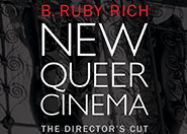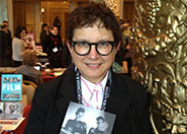



The term «New Queer Cinema» was coined by B. Ruby Rich in 1992. The US-American film critic and film theorist used the expression for the growing independent queer film production of the recent past – even the word «queer» was a relatively new word then.
New Queer Cinema mainly included films from the US and England, which focused on gay, lesbian and transgender life, love and, yes, suffering (AIDS!), too, and which were created by directors who knew about what they were speaking. The main characters of the films refused to comply with the standards and rules of a conventional – so-called heteronormative – society. Identity and sexuality were deemed theoretical constructs and flowing transitions preferred. Being lesbian or gay was no longer considered problematic but a matter of course.
For instance in Rose Troche’s «Go Fish» (1994) or the hyped up comedy «But I’m a Cheerleader» by Jamie Babbit. Cheryl Dunye, by contrast, created the first film with a black lesbian as the main character – «Watermelon Woman» – hereby inventing a new genre, the «Dunyementary». In the mid-eighties, when he was diagnosed with HIV, Derek Jarman could already look back at a considerable film oeuvre, such as «Sebastiane» and «Caravaggio». His contemporary Tom Kalin used film as a means to deal with AIDS and added «Swoon» to the list of New Queer Cinema films. Special Guest Mark Christopher will be presenting the newly cut Director’s Cut of his film «Studio 54» from 1998 and showing which homosexual story lines were refused by the producer at the time.
A film programme and a discussion with B. Ruby Rich and the filmmakers Cheryl Dunye, Tom Kalin and Mark Christopher, hosted by Skadi Loist will be held in context with this focus.
New Queer Cinema mainly included films from the US and England, which focused on gay, lesbian and transgender life, love and, yes, suffering (AIDS!), too, and which were created by directors who knew about what they were speaking. The main characters of the films refused to comply with the standards and rules of a conventional – so-called heteronormative – society. Identity and sexuality were deemed theoretical constructs and flowing transitions preferred. Being lesbian or gay was no longer considered problematic but a matter of course.
For instance in Rose Troche’s «Go Fish» (1994) or the hyped up comedy «But I’m a Cheerleader» by Jamie Babbit. Cheryl Dunye, by contrast, created the first film with a black lesbian as the main character – «Watermelon Woman» – hereby inventing a new genre, the «Dunyementary». In the mid-eighties, when he was diagnosed with HIV, Derek Jarman could already look back at a considerable film oeuvre, such as «Sebastiane» and «Caravaggio». His contemporary Tom Kalin used film as a means to deal with AIDS and added «Swoon» to the list of New Queer Cinema films. Special Guest Mark Christopher will be presenting the newly cut Director’s Cut of his film «Studio 54» from 1998 and showing which homosexual story lines were refused by the producer at the time.
A film programme and a discussion with B. Ruby Rich and the filmmakers Cheryl Dunye, Tom Kalin and Mark Christopher, hosted by Skadi Loist will be held in context with this focus.
Events in this context:




